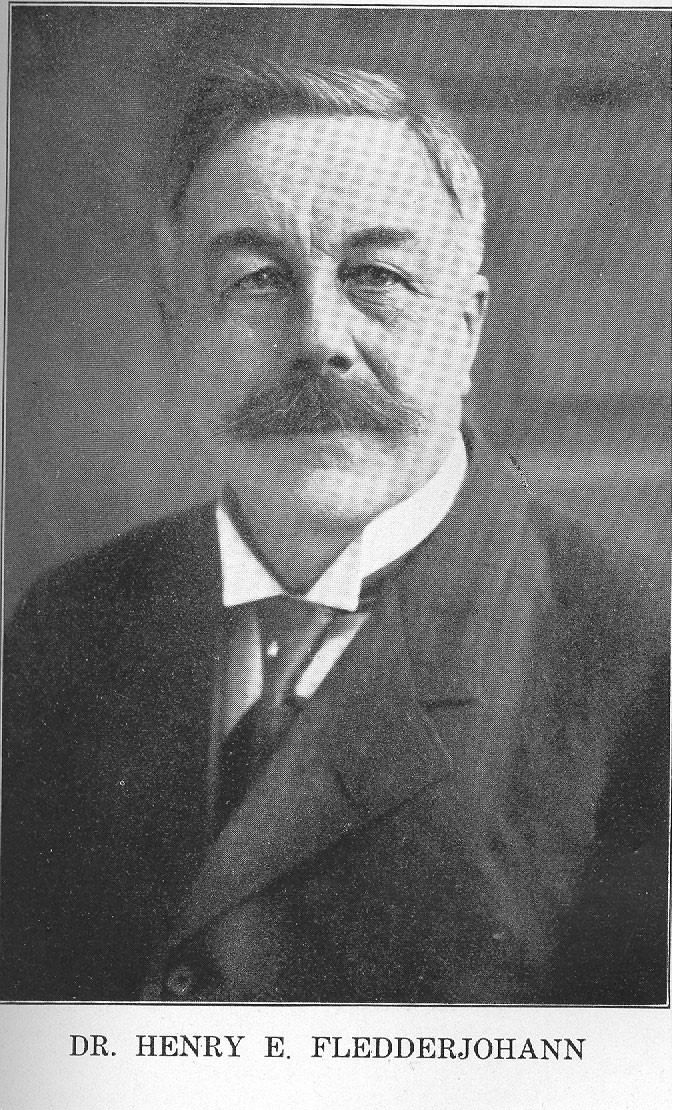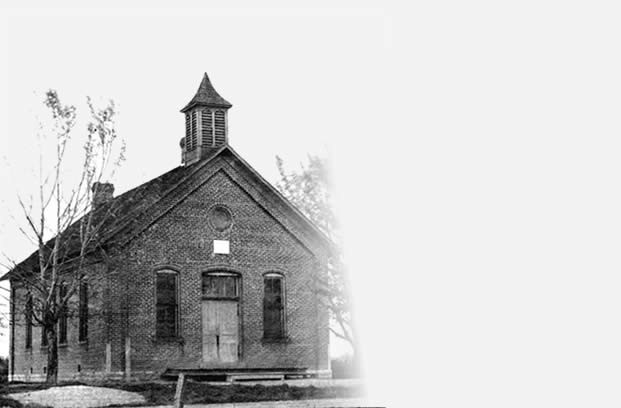Introduction to the 1923 Biographical Sketches
This biographical sketch was published along with many others in the 1923 History of Auglaize County, Volume II, edited by William J. McMurray and published by the Historical Publishing Company of Indianapolis. In most cases the subject of the biography was of the first generation born in this country to German immigrants. In some cases the subject may have been born in Germany and came to this country at a young age. In most cases the story tells of the immigrant parents of the subject and also the children and grandchildren of the subject named at the beginning of the story. In some cases comments have been added after the biography to explain the locations of the farms where the immigrants settled. New Knoxville did not have rural addresses until 1955, and therefore the settlers had rural route addresses of St. Marys, Botkins, etc.

DR. HENRY E. FLEDDERJOHANN, who has been engaged in the practice of medicine at New Knoxville for the past thirty-five years and is thus one of the oldest and best known physicians in this county, is a native son of Auglaize county, a member of one of the pioneer families here, and has lived in this county all his life. Doctor Fledderjohann was born on a farm west of New Knoxville, in Washington township, November 12, 1855, and is a son of Herman Henry and Catherine (Engle) Fledderjohann, both members of pioneer families in this county, and concerning whom further mention is made elsewhere in this volume. The late Herman Henry Fledderjohann, formerly and for many years one of the men of affairs of Auglaize county, was a native of Germany, born at Ladbergen, in Prussia, January 16, 1816, and was not yet twenty years of age when in 1835 he came to this country with his parents, Henry Fledderjohann and wife, the family proceeding on out into Ohio and settling in what in the next year came to be organized as Washington township, a part of Allen County, that having been thirteen years prior to the erection of Auglaize County. In the year of his arrival here, Henry Fledderjohann entered a tract of land from the Government in section 30, township 6 south, range 5 east (afterward Washington township), and there established his home, thus becoming one of the real pioneers of that part of what in 1848 came to be organized as Auglaize County. This tract was just a mile west of where in the next year (1836) the town site of New Knoxville was laid out at the site of the pioneer mill there. The Fledderjohann entry site on the west edge of Washington township was where the Pilger-Ruhe cemetery later came to be established. On that place the pioneer Henry Fledderjohann and his wife spent their last days, both dying during the time of the dreadful cholera epidemic which swept over this section in 1849. It was just about the time the Fledderjohanns came here that work on the Miami & Erie canal was begun, and Herman Henry Fledderjohann (better known as Henry), then twenty years of age, began working on the construction of that big engineering undertaking. He had learned the trade of carpenter in his native Prussia, and his ability along that line quickly raised him to a position of foreman of lock construction, in which capacity he superintended the construction of the locks in the canal here along the "divide," one of the most difficult bits of engineering in the whole course of the canal. After his father's death he came into possession of the home acres and also bought other timber lands in the county, thus becoming a considerable landowner, though farming was not his chief vocation. Following the completion of the canal, he built a saw mill at Lock 6, in section 26 of St. Marys township, about three miles south of St. Marys, and for forty years was engaged in the operation of that mill, finding a profitable outlet for his lumber in the canal traffic. He also had a hand in other enterprises and came to be recognized as one of the substantial and energetic men in the county, these activities continuing until his retirement, when advancing years warned him that he had done his part in community development. He lived to be past eighty-eight years of age, his death occurring at his home at Lock 6 on July 25, 1904. Herman Henry Fledderjohann was twice married and was the father of twelve children, all of whom save five—Frederick W., August H., Caroline M., Ernest F. and Anna M.—are living, the subject of this sketch having two sisters, Mina and Louise, and four brothers, Herman H., Benjamin A., George F. and Dr. Ferdinand F. Fledderjohann. Dr. Henry Fledderjohann was but a lad when his father established his home at Lock 6, and his public schooling was received in the school in that neighborhood and in the high school at New Bremen. Upon leaving high school he secured a license to teach, and for two winters was engaged in teaching in the district schools of this county. In the mean-time he had been giving his attention to preliminary studies in medicine and after a while entered the medical college of the University of Pennsylvania at Philadelphia, from which he was graduated in 1886. Upon receiving his degree, Doctor Fledderjohann returned home and opened an office for the practice of medicine at St. Marys. Eighteen months later he moved to New Knoxville, opened an office there and has ever since been engaged in practice at that place, one of the veterans of his profession in this county. Dr. Henry E. Fledderjohann was united in marriage to Emma M. Snethkamp, daughter of H. William Snethkamp, and to this union have been born five children, two of whom—Leona, the first born and Felix A., the fourth in order of birth—are deceased, the others being Frances, Walter R. and Zella H., the latter of whom married Ferdinand F. Eversman and has one child, a daughter, Jeanette Ann, Frances Fledderjohann, the elder daughter, married the Rev. Orin P. Schroerluke and has two children, Lois and Henry P. The Fledderjohanns are members of the German Reformed church, and Doctor Fledderjohann was secretary of the congregation of this church at New Knoxville for one term. In his political views the Doctor reserves his right to vote independently of party ties.


